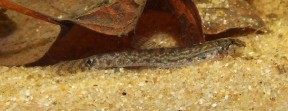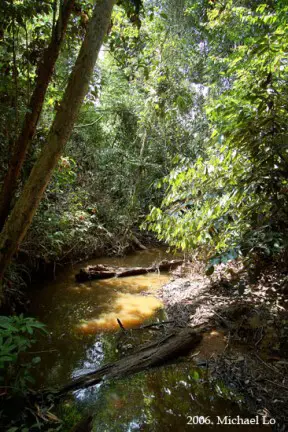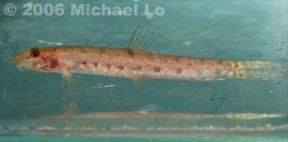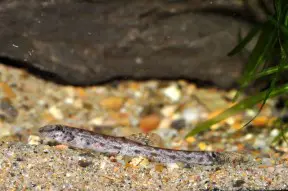Kottelatlimia pristes
SynonymsTop ↑
Lepidocephalichthys pristes Roberts, 1989
Etymology
Kottelatlimia: named for icthyologists Maurice Kottelat and Kelvin K. P. Lim, the authors who originally described K. katik, type species of the genus.
pristes: from the Greek pristes, meaning ‘saw’, in reference to the serrated pectoral-fin rays in males.
Classification
Order: Cypriniformes Family: Cobitidae
Distribution
This is the most widely-distributed member of the genus and has been reported from Selangor State, Peninsular Malaysia, Riau province, Sumatra (Indonesia), Sarawak State, Borneo (Malaysia), and throughout Kalimantan with the exception of Kalimantan Selatan (South Kalimantan) province, Borneo (Indonesia).
Type locality is given as ‘swampy stream about 30 kilometers west of Sintang on road from Sanggau to Sintang, Kapuas River basin, Barat, Kalimantan, Borneo’.
Habitat
Most commonly found in small, slow-moving forest streams with tannin-stained water, including both freshwater and blackwater peat swamps. Such habitats are typically shaded from the sun by marginal vegetation and the dense tree canopy above.
The water generally has a negligible dissolved mineral content, is poorly buffered and pH can be as low as 3.0 or 4.0 due to the gradual release of tannins and organic acids from decaying plant material.
Depending on locality the substrate may be composed of peat, mud or sand with the fish often abundant in piles of leaf litter.
In the North Selangor peat swamp, Peninsular Malaysia this species occurs alongside numerous other fishes including Rasbora cephalotaenia, R. einthovenii, R. kalochroma, Trigonopoma gracile, ‘Puntius‘ hexazona, ‘P.‘ johorensis, Nemacheilus selangoricus, Neohomaloptera johorensis, Hemirhamphodon pogonognathus, Betta bellica, B. livida, Parosphromenus harveyi, Sphaerichthys osphromenoides, and Trichopodus trichopterus.
In Sarawak it’s been collected at the same locality as Pangio doriae, P. shelfordii, P. semicincta and Acanthopsoides robertsi among others.
According to Kottelat and Tan (2008) it occurs sympatrically with K. hipporhynchos in some localities but whereas that species inhabits stretches of open sand K. pristes is always found among leaf litter or peat.
Maximum Standard Length
35 – 40 mm.
Aquarium SizeTop ↑
An aquarium with base dimensions of 45 ∗ 30 cm or more is recommended.
Maintenance
Not difficult to keep but must be provided with a soft, sandy substrate since some of its time is spent completely buried, or with only eyes protruding. When coarser gravel is used it may become stressed or damage itself trying to dig, and feeding behaviour can be inhibited.
Other décor is not essential but could include water-worn rocks or driftwood branches and tree roots. These should be added prior to the substrate to prevent them being toppled by digging activity, and be sure to leave open patches of sand between for the fish to move around in.
Lighting can be quite dim unless you intend to grow plants, which should ideally be of species able to grow attached to items of décor, while a few handfuls of dried leaf litter would complete the natural effect and provide additional cover.
Like many fishes that hail from pristine natural habitats it’s intolerant to accumulation of organic wastes and requires spotless water in order to thrive. For this reason it should never be introduced to biologically immature set-ups and adapts most easily to stable, mature aquaria.
Provided oxygenation is adequate water movement is unimportant although this species is also likely to do well in a river tank-style arrangement if the substrate is fine enough for it to dig.
Water Conditions
Temperature: 21 – 26 °C
pH: 3.5 – 6.5
Hardness: 0 – 90 ppm
Diet
Chiefly a micropredator sifting mouthfuls of substrate through the gills from which insect larvae, small crustaceans and suchlike are extracted.
It’s not difficult to feed in aquaria but offer a varied diet comprising sinking dried foods plus live and frozen Artemia, Tubifex, Daphnia, bloodworm, etc.
Behaviour and CompatibilityTop ↑
Not especially robust and shouldn’t be kept with much larger or more competitive fishes. Diminutive schooling cyprinids are ideal as are anabantoids such as Sphaerichthys or Parosphromenus spp.
If geography isn’t an issue many smaller, blackwater-dwelling characins should also work, while other substrate-dwelling loaches could include Pangio, Acanthopsoides or smaller Lepidocephalichthys spp.
Some nemacheilids are also suitable but proper research is essential as some can be excessively territorial or otherwise aggressive, require different water conditions or simply grow too large.
Kottelatlimia spp. are peaceful both with one another and other fishes and there exist no reports of them harming tankmates though they may prey on eggs or fry.
They seem to fare best in the presence of conspecifics and should ideally be kept in a group of 4 or more specimens.
Sexual Dimorphism
In mature males the first branched pectoral-fin ray is enlarged with 8-11 serrae (spine-like projections) running along the inner edge.
Adult females are typically heavier-bodied and a little larger then males.
Reproduction
Unrecorded.
NotesTop ↑
This species is occasionally encountered in the aquarium trade, sometimes as bycaych among shipments of other species and under fanciful names such as ‘Sumatran mini royal loach’ or Cobitis cf. sumatranus.
It differs from K. katik by: larger adult size (40 mm SL vs. 13.5); absence of a long nasal barbel (vs. presence); anatomy of the modified second pectoral-fin ray in males comprising 8-11 pointed, anteriorly-orientated serrae (vs. 6-7 fine, narrow serrae).
Features distinguishing it from K. hipporhynchos include: smaller adult size (40 mm SL vs. 52.3); lack of papillae on the mouth parts (vs. presence); a truncate to rounded caudal-fin (vs. slightly emarginate); shorter, less-slanted snout; a dark spot at the anal-fin origin and 2 rows of spots on the anal-fin rays (vs. anal-fin plain); anatomy of the modified first branched pectoral-fin ray in males comprising 8-11 pointed, anteriorly-orientated serrae (vs. a series of broad, contiguous posterior projections forming a blade-like structure).
The genus Kottelatlimia was erected by Nalbant (1994) to accommodate K. katik which had previously been assigned to Lepidocephalichthys but differs in various aspects noted earlier by Kottelat and Lim (1992) including: relatively small adult size; scaleless head; simple, curved suborbital spine; small eyes; enlarged second pectoral ray in males; possession of nasal barbels.
Lepidocephalichthys pristes was later moved by Kottelat and Whitten (1996) and the grouping currently contains three species following the description of K. hipporhynchos by Kottelat and Tan (2008).
The family Cobitidae, often referred to as ‘true’ loaches, is widely-distributed across most of Eurasia with the Indian subcontinent, Southeast Asia and China representing particular centres of species diversity.
Phylogenetic analyses by Tang et al. (2006), Šlechtová et al. (2007) and Šlechtová et al. (2008) revealed that the group constitutes a separate genetic lineage to the family Botiidae (the two were previously grouped together under Cobitidae as subfamilies Cobitinae and Botiinae).
In the most recent study Lepidocephalichthys was not found to be as closely-related to Pangio, Lepidocephalus or Kottelatlimia as previously hypothesised though unfortunately the authors stop short of proposing an alternative theory.
All cobitids possess sharp, motile, sub-ocular spines which are normally concealed within a pouch of skin but erected when an individual is stressed, e.g. if removed from the water. Care is therefore necessary as these can become entangled in aquarium nets and with larger species even break human skin.
References
- Roberts, T. R., 1989 - Memoirs of the California Academy of Sciences 14: i-xii + 1-210
The freshwater fishes of western Borneo (Kalimantan Barat, Indonesia). - Beamish, F. W. H., R. B. Beamish and S. L.-H. Lim, 2003 - Environmental Biology of Fishes 68(1): 1-13
Fish Assemblages and Habitat in a Malaysian Blackwater Peat Swamp. - Kottelat, M., 2012 - Raffles Bulletin of Zoology Supplement 26: 1-199
Conspectus cobitidum: an inventory of the loaches of the world (Teleostei: Cypriniformes: Cobitoidei). - Kottelat, M., 2013 - Raffles Bulletin of Zoology Supplement 27: 1-663
The fishes of the inland waters of southeast Asia: a catalogue and core bibliography of the fishes known to occur in freshwaters, mangroves and estuaries. - Kottelat, M. and H. H. Tan, 2008 - Zootaxa 1967: 63-72
Kottelatlimia hipporhynchos, a new species of loach from southern Borneo (Teleostei: Cobitidae). - Kottelat, M. and K. K. P. Lim, 1992 - Raffles Bulletin of Zoology 40(2): 201-220
A synopsis of the Malayan species of Lepidocephalichthys, with descriptions of two new species (Teleostei: Cobitidae). - Nalbant, T., 1994 - Travaux du Muséum d'Histoire Naturelle 'Grigore Antipa' 34: 375-380
Studies on loaches (Pisces: Ostariophysi; Cobitoidea). I. An evaluation of the valid genera of Cobitinae. - Tang, Q., H. Liu, R. Mayden and B. Xiong, 2006 - Molecular Phylogenetics and Evolution 39(2): 347-357
Comparison of evolutionary rates in the mitochondrial DNA cytochrome b gene and control region and their implications for phylogeny of the Cobitoidea (Teleostei: Cypriniformes). - Šlechtová, V., J. Bohlen and A. Perdices, 2008 - Molecular Phylogenetics and Evolution 47(2): 812-831
Molecular phylogeny of the freshwater fish family Cobitidae (Cypriniformes: Teleostei): delimitation of genera, mitochondrial introgression and evolution of sexual dimorphism. - Šlechtová, V., J. Bohlen and H. H. Tan, 2007 - Molecular Phylogenetics and Evolution 44(3): 1358-1365
Families of Cobitoidea (Teleostei; Cypriniformes) as revealed from nuclear genetic data and the position of the mysterious genera Barbucca, Psilorhynchus, Serpenticobitis and Vaillantella.









